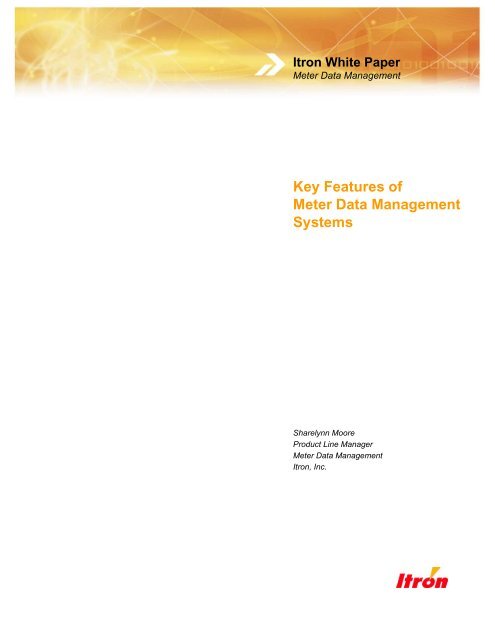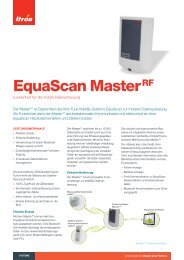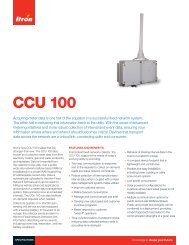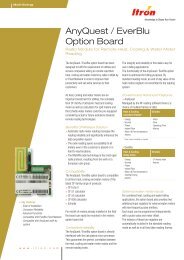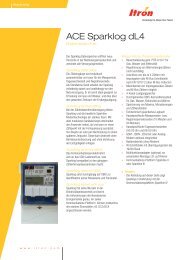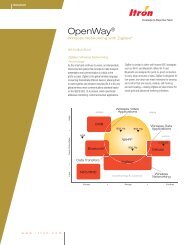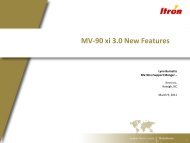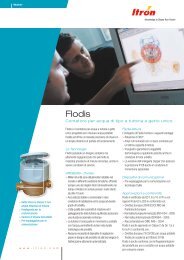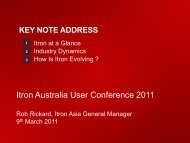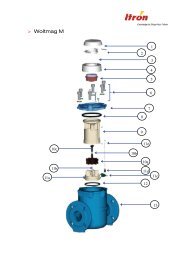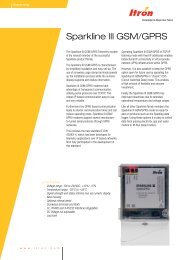Key Features of Meter Data Management Systems - Itron
Key Features of Meter Data Management Systems - Itron
Key Features of Meter Data Management Systems - Itron
- No tags were found...
You also want an ePaper? Increase the reach of your titles
YUMPU automatically turns print PDFs into web optimized ePapers that Google loves.
<strong>Itron</strong> White Paper<strong>Meter</strong> <strong>Data</strong> <strong>Management</strong><strong>Key</strong> <strong>Features</strong> <strong>of</strong><strong>Meter</strong> <strong>Data</strong> <strong>Management</strong><strong>Systems</strong>Sharelynn MooreProduct Line Manager<strong>Meter</strong> <strong>Data</strong> <strong>Management</strong><strong>Itron</strong>, Inc.© 2006, <strong>Itron</strong> Inc. All rights reserved. 1
Introduction 3Collection System Integration 4Interval <strong>Data</strong> <strong>Management</strong> 4Versioned <strong>Data</strong> Storage 6Two-Way Communications between AMI and CIS 7Platform to enable other AMI Applications 7Conclusion 8
IntroductionThe industry move toward smart metering has firmly established meter data management (MDM) as acritical component to realizing the full potential <strong>of</strong> advanced metering infrastructure (AMI), especiallywhen implemented prior to a large-scale residential AMI rollout. Many large investor-owned utilitiesadvocate that with the proper architecture in place, AMI will have an immediate impact on theircompany’s business processes. A meter data management system eases IT integration <strong>of</strong> AMI, andfacilitates the distribution <strong>of</strong> the meter data across the utility enterprise by framing the volumes <strong>of</strong> intervaldata retrieved from the field into manageable and familiar information. Additionally, by consolidatingreading data from multiple collection systems into one MDM, utilities can set consistent validationroutines to truly evaluate the performance <strong>of</strong> their AMI systems.The definition <strong>of</strong> a meter data management solution can vary widely. At a minimum, MDM provides adatabase repository and utility-specific business logic to:• Automate and streamline the complex process <strong>of</strong> collecting meter data from multiple meter data collectiontechnologies• Evaluate the quality <strong>of</strong> that data and generate estimates where errors and gaps exist• Deliver that data in the appropriate format to utility billing systemsThe critical role <strong>of</strong> an MDM system is to pre-process granular interval meter data at large volumes veryquickly. In the past, only commercial and industrial (C&I) meters collected interval data, whilespecialized systems were required to collect, store and compute bills. But with the onset <strong>of</strong> AMI, theentire meter population is now bringing back this data. Not only is there more data, but the data is morecomplex. The customer information system (CIS) will still be responsible for the commercial processing<strong>of</strong> this data, but an MDM system must aggregate and pre-process this granular interval data as specializedC&I data management systems have done in the past. The sheer volume <strong>of</strong> meter data from AMI systemsrequires consistent, corporate-wide “best practice” rules for managing the increased potential for dataerror and confusion. As smart meters or AMI are deployed, the MDM must also handle the storage anddistribution <strong>of</strong> non-billing data and messaging such as two-way commands, outage alarms, tamper alarmsand demand response events. As the utility industry evolves, an MDM solution must also have the abilityto facilitate change within the IT department by isolating changing collection and back <strong>of</strong>fice solutionsand practices.Most meter data management systems today claim to integrate multiple collection systems, calculatebilling determinates and do some level <strong>of</strong> validation, estimation and editing <strong>of</strong> meter data. But whenutility business and IT departments embark on the purchase and implementation <strong>of</strong> a meter datamanagement solution, it’s critical to understand the key features and true system capabilities whichdistinguish each, and to understand whether those features can perform at AMI scales. An MDM solutionmust deliver the results utilities need today and tomorrow:• Collection system integration• Interval data management• Versioned data storage
• Two-way communications between CIS and AMI systems• Provide a platform to enable other AMI applications and business processesCollection System IntegrationUtilities are investing in solutions that will include multiple AMI and meter reading systems that supplymeter data through a complex set <strong>of</strong> interfaces to one or more utility billing systems. Different read ratesand multiple AMI network choices and legacy meter reading systems are just a few <strong>of</strong> the facts <strong>of</strong> dailyutility life that can humble even the best utility CIS. An MDM solution that can effectively broker readrequests and responses between the billing system and each meter reading system not only ensures timelyreads to the CIS, but can:• Simplify future integration <strong>of</strong> new AMI technologies• Enable ad hoc, <strong>of</strong>f-cycle read requests by the CIS• Manage collection <strong>of</strong> meter readings and facilitate two-way requests from multiple technologies for the samemeter• Simplify integration <strong>of</strong> new meter reading and billing system technologies acquired through merger andacquisition• Validate, edit and store commercial and industrial readings along with mass market residential readings• Allow utilities to migrate from AMR to AMI over time• Enable the piloting and deployment <strong>of</strong> multiple AMI technologiesRequest and response brokering allows a billing system to request and receive aggregated billingdeterminants and meter reads in its existing mode <strong>of</strong> operation, as if a single meter reading system weredeployed even though multiple technologies may be in use. The MDM maintains the necessaryinformation about the collection system used to obtain readings from each meter in order to interact witheach one appropriately. When a reading window opens, the MDM can bundle readings from multiplereading systems into a single, integrated response to the billing system.Effective collection system integration allows merged utilities to adopt new technologies and unify billingprocesses without having to completely re-engineer existing meter reading processes or extensivelymodify the chosen billing system or billing processes. All meter reading processes can follow the sameautomated, consistent path to billing. This also simplifies the spot deployment <strong>of</strong> new meter readingtechnologies, once again without modifying the existing billing processes or systems.Because meter reading systems can vary widely in read frequency and overlap in geographic area, requestand response brokering functionality should also include user-definable logic for processing questionablereads. The MDM should enable users to define “best read” logic for using multiple and overlappingreadings within the same request window. If valid readings cannot be obtained within the readingwindow, the MDM can derive an acceptable reading or initiate a new read request using a variety <strong>of</strong>business rules. With these capabilities, MDM can be configured to calculate an estimated read, include aninvalid reading flagged with an invalid indicator, or invoke an automated gap fill process to re-requestreadings from the appropriate collection engine.Interval <strong>Data</strong> <strong>Management</strong>With AMI, utilities have a new challenge—and opportunity—to manage interval data across the entiremeter population. AMI brings the need to provide what was once considered complex billing for C&I
customers to the residential market. Utilities are well accustomed to the fact that some percentage <strong>of</strong> C&Iinterval data will be missing, redundant or incorrect. Interval data collected from residential metersprovides no exception to this rule. <strong>Data</strong> validation, estimation and editing (VEE) is a process thatidentifies problematic data that comes from meter data collection systems before it reaches other utilitysystems and provides tools for addressing quality issues according to a utility’s specific best practice rulesand meter-specific parameters.Each utility and each energy consumer is unique. Having the flexibility to handle data anomalies such asgaps, overlaps and redundancies, as well as tolerance issues between consumption reads and interval data,with a reliable, auditable process is a critical MDM feature. MDM should provide utilities with the abilityto specify validation logic via an integrated calculation engine. When validation fails, the MDM systemcan be configured to execute contingencies, such as automatically estimating the read or passing a “noread”to produce a failed validation report.VEE capabilities are critical to ensuring a utility’s business and regulatory process needs are met with asuccessful MDM deployment. Effective VEE should provide utilities with the ability to create a host <strong>of</strong>standard parameter-based and user-defined algorithms, with full transparency and reporting on thedevelopment <strong>of</strong> those algorithms. MDM vendors can vary widely on their VEE capabilities. Thefollowing are some <strong>of</strong> the fundamental validation and estimation functions that the MDM system shouldenable:• Estimate interval data based on meter readings• Replace all values with a constant• Multiply or divide by a constant• Add or subtract a constant• Slide a range <strong>of</strong> interval data ahead or back in time• Perform linear interpolation• Split or combine intervals• Restore a previous versionAdditionally, utilities should be able to edit values using a host <strong>of</strong> standard editing functions:• Add or replace values manually• Modify read status• Display or edit multiple reads• Copy or cut/paste a string <strong>of</strong> values from one meter to another• Copy or cut/paste values from a spreadsheetWith regard to billing, utilities have traditionally relied on external spreadsheets for the complexcalculations required to convert interval data into large commercial and industrial energy charges. Time<strong>of</strong>-useand critical peak pricing programs, for example, require unit conversions, complex loadcalculations and aggregations. While the pool <strong>of</strong> customers that have traditionally been billed in thismanner has been comparatively small, many utilities are now looking at interval data, time- and price-
sensitive rate structures for residential and small C&I customers to better influence consumption patternsand manage changing energy markets.MDM solutions that provide an integrated calculation engine enable utilities to do away with hard-tomaintainspreadsheets and manual, error-prone methods for producing billing determinants. A calculationengine should support all <strong>of</strong> the common mathematical operators and functions as well as conditional andlogical functions, ideally in a simple, intuitive spreadsheet interface. Examples include:• Common operators: +, –, x, /, square root, square, sine, cosine, etc.• Condition/logical functions: if, and, or, not, >, =, etc.• Time and date functions: max, min, avg, total, etc.• Unit conversions: kWh/kVARh to kVAh, power factor/V2H to V, etc.This broad functionality enables users to calculate nearly any complex load, loss or aggregation for billingapplications, as well as calculations for other utility processes, such as the estimation in VEE. Within thecontext <strong>of</strong> a meter data management solution, billing determinants can be calculated and deliveredautomatically upon the request <strong>of</strong> the billing system with no manual interventions. A calculation enginesimplifies updating and maintaining calculations. Versioning tracks the changes. Standard MDMinterfaces make new and edited calculations immediately available for all utility applications. This puts anend to three problems utilities have had for years:• Replaces manual data import and export processes with automated processes that are secure and auditable• Provides a single calculation for use by all utility systems. No longer does the same load data generate slightlydifferent values depending on which utility spreadsheet was used.• Provides scenario planning to run “what if” scenarios for different rate types across different customer classes orother strataVersioned <strong>Data</strong> StorageUnderstanding what load data was “the best available” at a point in time is a critical MDM capability.MDM load data versioning maintains snapshots <strong>of</strong> each meter read associated with a time reference,making it much easier to resolve billing and settlement questions and disputes. Versioned data is alsocritical to maintaining data integrity as that data is shared across multiple utility systems (demandresponse, load research, forecasting, distribution asset analysis, etc.). As this single source <strong>of</strong> databecomes a central resource to multiple utility systems, the ability to reproduce a data set as it would haveappeared at a particular date and time becomes vital. In some jurisdictions, it is a requirement to be ableto reproduce versions <strong>of</strong> data that were sent at various stages for market settlement. New accountingstandards and regulations, such as the Sarbanes-Oxley Act, make auditors much less forgiving <strong>of</strong>undocumented data changes.MDM solutions with versioned data storage should provide log records indicating which user or VEEprocess made changes to the data. For example, if a reading changes five times, the MDM creates fiveversions <strong>of</strong> that reading, each <strong>of</strong> which also has a reference time period, indicating when it was the currentversion.
Two-Way Communications between AMI and CISWith two-way communications to the meter, utilities can perform on-request reads to help settle customerbill disputes. With a customer on the phone, customer service representatives can request the most recentmeter read for accurate and timely information relative to the disputed bill. Two-way communicationsallow interval meter data to be requested to fill gaps in information that may not have made it to thecollection engine database.Two-way communications also open the door for ping commands, load-side voltage checks to determinecustomer-side breaker issues, and remote connect and disconnect. Additionally, MDM can help initiatethese events and brokers the request back to CIS or other systems. Further, there are advanced capabilitiesyet to be considered. This value-added potential <strong>of</strong>fers promise given the capabilities <strong>of</strong> AMI systems andfuture demands for more near-real time availability <strong>of</strong> data.Platform to enable other AMI ApplicationsWhen choosing an MDM system, consideration should be made for other applications that can easilyleverage the same s<strong>of</strong>tware platform without a lot <strong>of</strong> custom design. Other applications that leverage theMDM database platform should be available either by add-on modules or integrated as part <strong>of</strong> anenterprise MDM approach. Some common AMI applications are listed below.Revenue Protection and Theft AnalysisIn terms <strong>of</strong> suspected theft, the importance <strong>of</strong> meter usage data can not be overlooked. Utilizingmeter usage data, along with tamper data, helps to better create suspect lists for theft. An MDMsolution should <strong>of</strong>fer the infrastructure and analysis capabilities to analyze this information,native within the MDM or as part <strong>of</strong> an add-on application or module. Combining this addedfunctionality with today’s AMR and AMI systems reduces a utility’s workforce in the field, aswell as transportation and gasoline costs. In turn, the MDM and its more robust data analysis canbe used to <strong>of</strong>fset the loss <strong>of</strong> a monthly presence in the field.End Customer Analysis and Presentment<strong>Meter</strong> data management systems allow customers to have more information about their energyuse and, therefore, more control over it. The MDM solution is a key enabler for allowing thepresentment <strong>of</strong> information back to end consumers. When considering purchase <strong>of</strong> an MDMsystem, keep in mind that it should provide additional applications or open API standards tointegrate into customer service systems so the utility has the flexibility to ensure its consumersand customer service representatives have the tools they need.Load Curtailment and Demand ResponseAn MDM system stores information and makes it available to dramatically improve the extent <strong>of</strong>load curtailment and demand response by:• Offering load studies across broader customer sets• Providing the tools necessary to determine the most appropriate rate-based demand response programs• Producing applications to administer C&I load curtailment programs• Presenting applications to manage rate-based residential demand response programs via dynamic rates
Conclusion<strong>Meter</strong> data is emerging as the utility’s greatest asset. As utilities adopt MDM solutions to manage theirever-increasing meter data, the industry is witnessing the revolutionary impact MDM and AMI can haveon operational efficiencies, customer service, energy forecasting, distribution system reliability,regulatory compliance and more. Selecting the right MDM solution is not only important to achieve areasonable return on these investments, but critical for achieving the transformational changes that canposition utilities for success in an ever-changing business landscape. If you’re in the market for an MDMsolution that can deliver these results, ask vendors if their systems have the key features mentioned in thisdocument. Make sure the MDM solution you buy has the tools you need to deliver the full value <strong>of</strong> meterdata to your utility.
<strong>Itron</strong> Inc.<strong>Itron</strong> Inc. is a leading technology provider to the global energy and water industries. <strong>Itron</strong> Inc. consists <strong>of</strong><strong>Itron</strong> in North America and Actaris outside <strong>of</strong> North America. Our company is the world’s leadingprovider <strong>of</strong> metering, data collection and utility s<strong>of</strong>tware solutions, with nearly 8,000 utilities worldwiderelying on our technology to optimize the delivery and use <strong>of</strong> energy and water. Our products includeelectricity, gas and water meters; data collection and communication systems, including automated meterreading (AMR) and advanced metering infrastructure (AMI); meter data management and relateds<strong>of</strong>tware applications; project management, installation, and consulting services.To know more, start here: www.itron.com<strong>Itron</strong> Inc.Corporate Headquarters2111 North Molter RoadLiberty Lake, Washington 99019U.S.A.Tel.: 1.800.635.5461Fax: 1.509.891.3355Due to continuous research, product improvement and enhancements, <strong>Itron</strong> reserves the right to change product or system specifications without notice. <strong>Itron</strong> is a registered trademark<strong>of</strong> <strong>Itron</strong> Inc. All other trademarks belong to their respective owners. © 2008, <strong>Itron</strong> Inc.Publication 100701WP-0306/08


